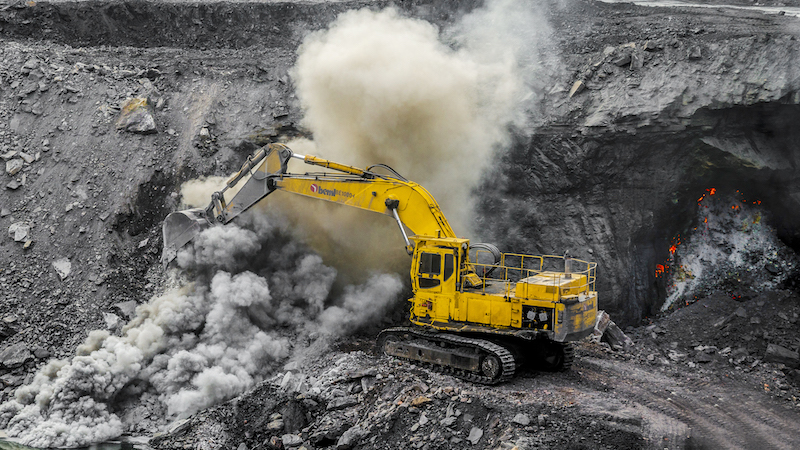Coal India, the state-owned monolith that produces almost all of the country’s coal, sees a slowdown coming, according to an internal prognosis.
That’s despite government efforts this week to open up India’s coal mining sector to competition.
Entitled Coal Vision 2030, the report – which has been circulated to stakeholders for consultation – warns that cheap solar power, climate commitments and economic factors are likely to have a “significant impact” on the coal sector.
“Even in the case of coal industry in India, trends portent [sic] that in the long run the demand is likely to decrease substantially,” it states. “With the increasing threat of climate change impacting humanity (irrespective of the US position) and the global funding focus on renewables, it is a matter of time when alternate clean energy would displace coal.”
Yet the raw numbers in Coal India’s analysis tell a different story, predicting coal use roughly doubling to 1,300-1,900 million tonnes in 2030.
“The messages are extremely contradictory,” Swati D’Souza, energy policy expert at the Delhi-based Energy and Resources Institute (Teri), told Climate Home News. “The [coal demand] numbers are very high given current trends on solar and wind penetration in the power sector… The document does not really give clarity on how they arrived at these numbers.”

Demand projections in Coal India’s Vision 2030 report. The upper end of the spectrum corresponds to a GDP growth rate of 8%. The lower end corresponds to an energy efficient scenario.
Ted Nace, director of Coal Swarm, which tracks the development of coal power plants globally, described 1,900Mt as “an absurd figure for coal demand in 2030”. Coal India did not respond to emailed questions about the basis of its projections.
In January 2018, India had 215GW of coal power generation capacity installed, by Coal Swarm’s count. There was 44GW under active construction and 17GW of planned plants where building was frozen. Net annual growth has fallen to around 5GW.
“Finance has completely dried up for privately sponsored coal plants; the only ones moving forward at this point are government-owned,” Nace said. “Without significant growth in coal power capacity there will not be the doubling or tripling of coal demand that this report talks about.”
The Central Electricity Authority is assuming no new coal plants will be connected in the next decade beyond those already in the pipeline. By 2026, Teri forecasts renewable sources and energy storage will be cheaper than coal generation.
Report: International Solar Alliance to launch 121 projects at New Delhi summit
India’s energy trajectory is critical to global efforts to avert dangerous climate change. Prime minister Narendra Modi has set ambitious renewable energy targets and launched an international push to accelerate solar power deployment.
All the same, coal remains India’s main fuel, generating three quarters of electricity. Efforts to expand grid access to millions of households and boost manufacturing are only increasing demand for power.
On Tuesday, the government’s economic committee approved a plan to boost efficiency and production by liberalising the coal mining market and breaking Coal India’s monopoly.
Private sector players broadly welcomed the move. “This is bold reform,” Anil Agarwal, chairman of multinational mining company Vedanta told Economic Times. “Some of the most evident benefits of this measure would be enhanced energy sufficiency for India and availability of power at lower costs for the end consumer.”
But others had doubts. The same article quoted a senior mining executive who suspected the only blocks available for auction would be those rejected by Coal India as too difficult to mine.

Falling solar power and battery costs will make off-grid systems increasingly competitive with coal generation (Source: US DoE, KPMG analysis)
The incumbent’s strategy document sends a discouraging message to would-be market entrants, forecasting no need for new mines beyond those already in planning.
“In view of the likely demand (base case scenario), there is limited requirement of starting new coal mines except the ones already auctioned/ allocated,” says the Vision 2030 report.
“Adverse geology” and higher land acquisition costs may make future coal production less competitive, it adds: “Compared to alternative sources, particularly solar, coal could be increasingly disadvantaged.”
While its core demand projections remain high, Coal India notes a mass shift to off-grid electricity systems could lower coal use below that range.
Clean technology developments make such systems increasingly viable. The report cites forecasts that solar panels will compete with coal generation on price by 2025 and battery costs will drop from 250 rupees ($3.86) a kilowatt hour to 50 rupees ($0.77) by 2030.
“It is futile to project beyond this period in such a dynamic environment,” the report says, recommending a review of the technology every three years.
